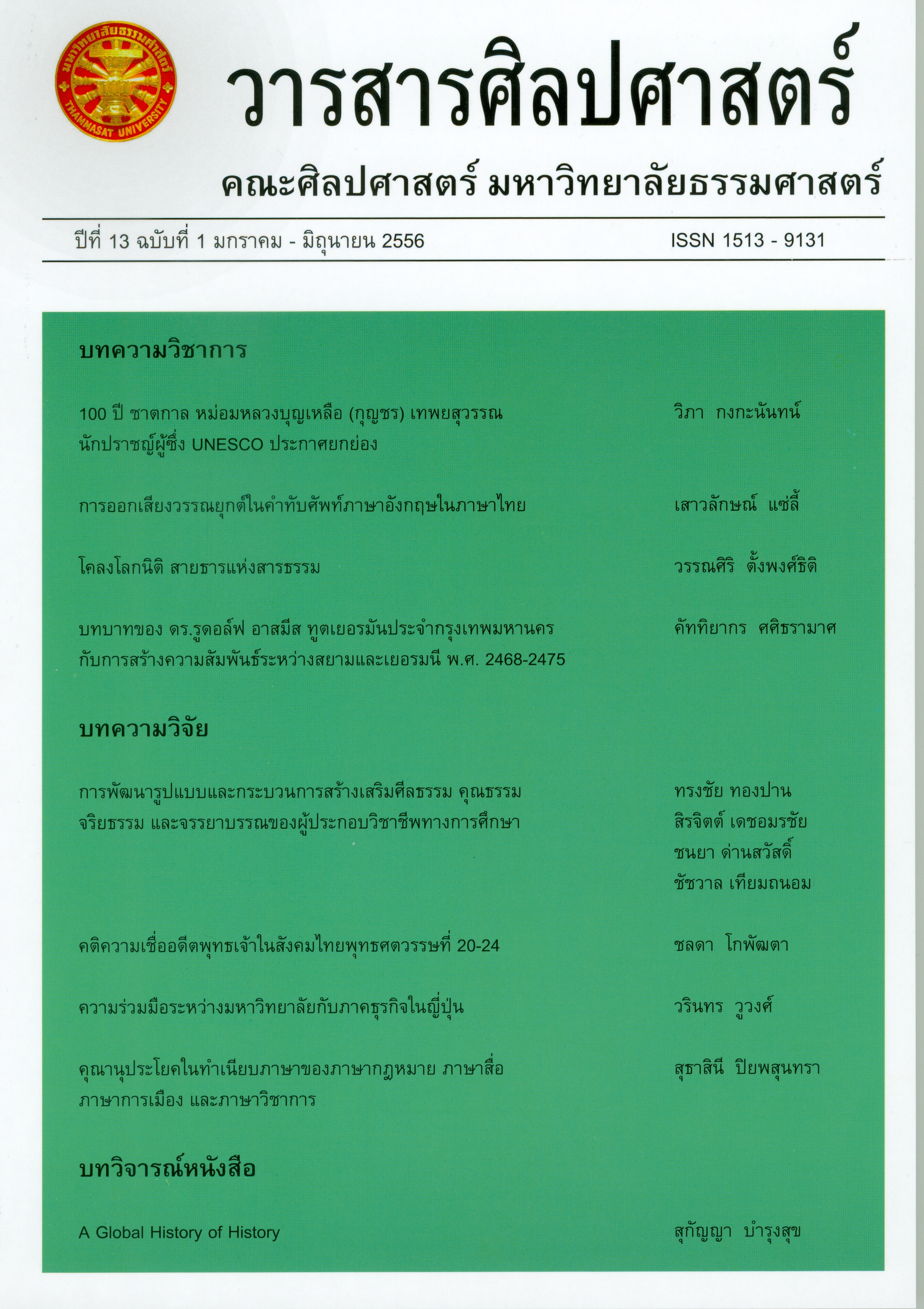การออกเสียงวรรณยุกต์ในคำทับศัพท์ภาษาอังกฤษในภาษาไทย
Main Article Content
บทคัดย่อ
การศึกษานี้มีวัตถุประสงค์เพื่อวิเคราะห์หาระบบการออกเสียงวรรณยุกต์ในคำทับศัพท์ภาษาอังกฤษในภาษาไทยมาตรฐาน ข้อมูลที่ใช้ในการศึกษาเป็นคำทับศัพท์จำนวน 738 คำ เก็บจากนิตยสาร หนังสือพจนานุกรมคำใหม่ เล่ม 1 และเล่ม 2 ฉบับราชบัณฑิตยสถาน และหนังสือศัพท์ต่างประเทศที่ใช้คำไทยแทนได้ ฉบับราชบัณฑิตยสถาน ซึ่งรวบรวมคำใหม่ไว้ โดยไม่ได้นำคำศัพท์ที่บันทึกไว้แล้วในพจนานุกรมฉบับ พ.ศ. 2542 มาวิเคราะห์ ข้อมูลจำแนกออกเป็นคำพยางค์เดียว คำสองพยางค์ คำสามพยางค์ และคำเป็นคำตาย และตรวจสอบการออกเสียงวรรณยุกต์จากบุคลากรในมหาวิทยาลัยราชภัฏสวนสุนันทาจำนวน 10 คน
ผลการศึกษาข้อมูลพบว่า ประการแรก คำทับศัพท์ภาษาอังกฤษพยางค์เดียวมีเสียงวรรณยุกต์ 3 เสียง ได้แก่ สามัญ เอก และตรี ซึ่งคำเป็นมีเสียงสามัญและตรี ส่วนคำตายมีเสียงเอกและตรี ประการที่สอง คำทับศัพท์สองพยางค์ที่เป็นคำเป็นทั้งคู่มีวรรณยุกต์ 3 เสียง ได้แก่ สามัญ โท และตรี พยางค์แรกมีเสียงสามัญและเสียงตรี ส่วนพยางค์หลังมีเสียงโท เสียงสามัญ และเสียงตรี ประการที่สาม คำทับศัพท์สองพยางค์ที่เป็นคำตายทั้งคู่ มีวรรณยุกต์ 4 เสียง ได้แก่ สามัญ เอก โท และตรี พยางค์แรกมีเสียงตรีและเสียงสามัญ ส่วนพยางค์หลังมีเสียงเอก เสียงตรี และเสียงโท ประการที่สี่ คำทับศัพท์สองพยางค์ที่มีพยางค์แรกคำเป็นและพยางค์หลังคำตาย มีวรรณยุกต์ 4 เสียง ได้แก่ สามัญ เอก โท ตรี พยางค์แรกมีเสียงสามัญ และเสียงตรี ส่วนพยางค์หลังมีเสียงเอก เสียงตรี และเสียงโท ประการที่ห้า คำทับศัพท์สองพยางค์ที่มีพยางค์แรกคำตาย และพยางค์หลังคำเป็นมีวรรณยุกต์ 4 เสียงเช่นกัน พยางค์แรกมีเสียงตรี เสียงสามัญ และเสียงเอก ส่วนพยางค์หลังมีเสียงโท เสียงสามัญ และเสียงตรี นอกจากนี้ในข้อมูล คำสองพยางค์ทุกกลุ่มยังมีคำที่ออกเสียงวรรณยุกต์แตกต่างกันจำนวนหนึ่ง และประการสุดท้าย คำทับศัพท์สามพยางค์จำแนกข้อมูลได้ 4 กลุ่ม ได้แก่กลุ่มคำเป็นทั้งหมด กลุ่มคำตายทั้งหมด กลุ่มที่มีพยางค์สุดท้ายคำเป็น และกลุ่มที่มีพยางค์สุดท้ายคำตาย พบว่าในตำแหน่งพยางค์สุดท้ายของคำเป็นมีเสียงวรรณยุกต์สามัญ โท และตรี ส่วนคำตายมีเสียงวรรณยุกต์เอกและตรี ส่วนพยางค์ตำแหน่งอื่นมีเสียงวรรณยุกต์ตามที่ปรากฏในคำพยางค์เดียวและคำสองพยางค์
The purpose of this research was to study the tone of English loanwords that appeared in standard Thai. The data were 738 words collected from magazines and ‘Photchananukrom Kham Mai’ and ‘Sap Tangprathed Thi Chai Kham Thai Than Dai’. Both books are dictionaries issued by the Royal Institute that archived new and contemporary words. However, the words collected in The Royal Institute Dictionary circa B.E. 2542 were excluded from this research. The data were divided into 3 types: one–syllable, two–syllable and three–syllable words. The aspects of smooth syllables and checked syllables were described as the influential factors on tonal assignment. The tone productions of English loanwords were tested on 10 officials from Suansunandha University.
The study results revealed that a tone was assigned to all loanword syllables, although with some variations. One syllable loanwords contain the following characteristics: smooth syllable have mid and high tones, while checked syllable have high and low tones. Two syllables loanwords exhibited more complex variation of tonal patterns. If both were smooth syllables, the first syllable was assigned with mid and high tones, while the second syllable with falling, mid and high tones. If both were checked syllables, the first was assigned with high and mid tones, while the other with low, high and falling tone. It should be noted that the researcher also found further variations in checked and unchecked syllables. In some cases, if two-syllables loanwords contained the first syllable as an unchecked syllable and the second as a checked one, the first would be assigned with mid and high tones and the second with low, high and falling tones. If the case was reversed with the checked syllable in the first position, the first syllable would be assigned with high, mid and low tones, while the second syllable with falling, mid, and high tones. Lastly, the study on three–syllable words focused on the final syllable as the first and second syllable showed similar tonal similarities with one and two-syllables loanwords. If the final syllable was a smooth syllable, it would register as mid, falling and high tones. On the other hand, if it was a checked syllable, it would register as low and high tones.


